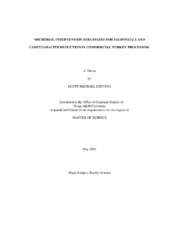Microbial intervention strategies for Salmonella and Campylobacter reduction in commercial turkey processing
Abstract
One objective of the present investigation was to compare Salmonella and
Campylobacter recovery incidence from commercially processed turkeys immediately
prior to and following pre-chill and immersion chiller intervention strategies being used
in three distinct turkey processing facilities. In each plant, on a single day of processing,
100 carcass rinse samples prior to and following each post-evisceration, pre-chill
intervention and following immersion chilling were obtained for Salmonella and
Campylobacter recovery. Two of three plants demonstrated a trend of decreased
Salmonella on carcasses following the Inside Outside Bird Wash (IOBW), with
reductions of 13%, and 11% being observed for Plants 1 and 2, respectively. Results for
reductions of Campylobacter contamination were not as straightforward, with only Plant
3 showing decreased levels (11% reduction) following the IOBW. Plant 2 used an
additional pre-chill intervention, a low pressure, acetic acid final wash, which was not
shown to be effective in causing an additional reduction in either Salmonella or
Campylobacter on carcasses. In all three plants, properly managed immersion chilling
systems were the most effective microbial intervention for achieving Salmonella andCampylobacter reduction on processed turkey carcasses. While not as effective, the
IOBW present in each plant likely contributed to the effectiveness of immersion chiller
interventions. If managed properly these intervention points have demonstrated
themselves as a viable means to effectively reduce Salmonella and Campylobacter on
processed turkeys.
Another objective was to modify the scalder environment to an alkaline pH and
determine the effects of thermal killing of Salmonella and Campylobacter. In each
plant, on a single day of processing, 50 carcass rinse samples prior to and following
scald tank immersion and following feather removal were obtained for Salmonella and
Campylobacter recovery. Modification of the scald water to alkaline conditions (pH 9-
10) did not result in increased thermal killing of Salmonella or Campylobacter on turkey
carcasses, as hypothesized before the investigation. Alkaline conditions are known to
facilitate a more efficacious pluck and aid in the detachment of bacteria. Due to this, the
bacteria that were recovered at these points on the processing line could have had an
impact on the observed data.
Citation
Stevens, Scott Michael (2005). Microbial intervention strategies for Salmonella and Campylobacter reduction in commercial turkey processing. Master's thesis, Texas A&M University. Texas A&M University. Available electronically from https : / /hdl .handle .net /1969 .1 /2378.


